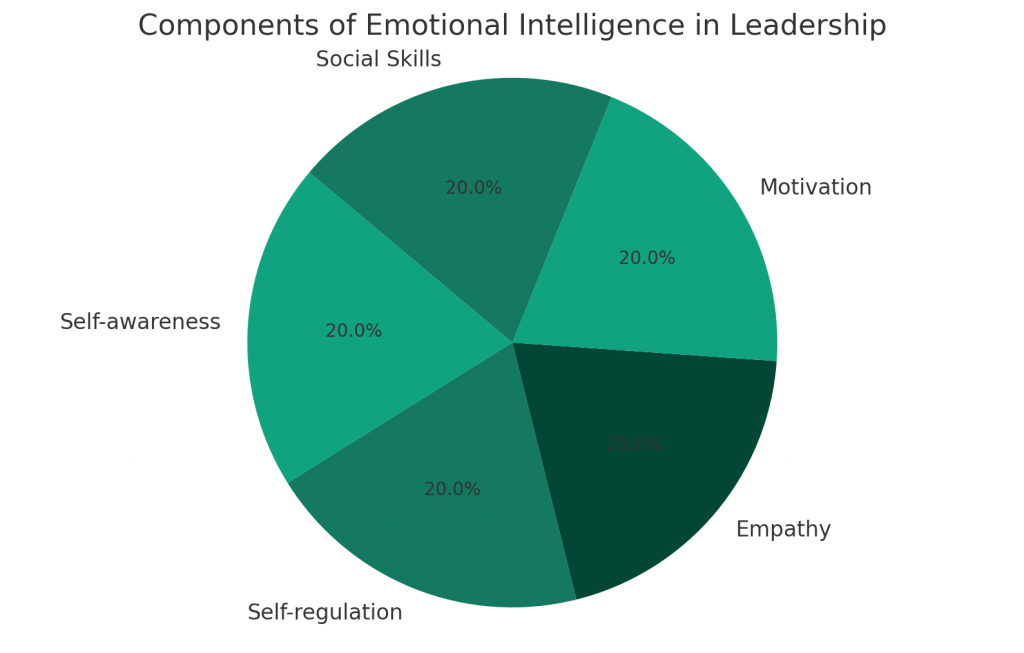Imagine leadership as a voyage across the vast ocean of human interaction, where the ‘Emotional Tides’ play a crucial and often underestimated role. In the realm of leadership, emotions are not just fleeting feelings; they are powerful undercurrents that can propel or hinder the journey towards effective leadership. This concept of ‘Emotional Tides’ encompasses the ebb and flow of emotions that leaders experience and navigate daily. It represents the complex emotional landscape that leaders must traverse, influencing their decisions, actions, and ultimately, their effectiveness.
Emotions in leadership are like the unseen forces beneath the ocean’s surface – they can guide a ship smoothly or steer it into turbulent waters. The role of emotions in leadership extends beyond personal feelings; it profoundly impacts team dynamics, organizational culture, and decision-making processes. Emotions drive motivation, empathy, resilience, and connection, all crucial ingredients for successful leadership. Understanding and harnessing these emotional tides is not just beneficial; it’s essential for leaders who aim to inspire, motivate, and lead effectively in today’s diverse and ever-changing organizational landscapes.
This exploration into the world of emotional leadership aims to dissect the intricacies of emotional management within the leadership context. Our voyage will uncover strategies to recognize, understand, and harness emotional currents for positive leadership outcomes. We’ll delve into the importance of balancing emotional intelligence with rational decision-making, ensuring leaders can ride the waves of their emotions without losing sight of their goals. The journey promises to equip leaders with the tools and insights needed to master their emotional tides, transforming them into a source of strength and influence.
The Emotional Spectrum of Leadership
Understanding the Influence of Emotions in Leadership Decisions
The spectrum of emotions in leadership spans a wide range, from the heights of joy and excitement to the depths of frustration and disappointment. Each emotion carries its own influence on decision-making. Leaders who understand the power of their emotions can use them to enhance their decision-making process, ensuring that their choices are not only logical but also empathetically and ethically sound. Emotions can provide valuable insights into the needs and motivations of both the leader and their team, leading to more inclusive and effective decisions.
Balancing Emotional Intelligence with Rational Decision-Making
The art of leadership requires a delicate balance between emotional intelligence and rational thought. Emotional intelligence – the ability to perceive, understand, and manage emotions – is a key skill that allows leaders to connect with their teams, navigate complex social dynamics, and create an environment of trust and respect. However, this emotional acuity must be complemented by rational decision-making to ensure that choices are pragmatic, strategic, and aligned with organizational goals. This balance is crucial for leaders to respond effectively to both the emotional and practical demands of their roles.
Navigating the Emotional Landscape of Leadership
Identifying and Understanding Your Emotional Triggers
Navigating the emotional landscape of leadership begins with self-awareness, particularly in understanding your emotional triggers. These triggers are specific events or interactions that elicit strong emotional reactions, potentially impacting your leadership effectiveness. To identify these triggers, engage in reflective practices like journaling or mindfulness. Pay attention to situations where your emotions feel intense or overwhelming. Understanding these triggers allows you to anticipate and prepare for emotional responses, thereby enhancing your emotional control and leadership presence.
Regulating Emotions for Effective Leadership
Once you identify your emotional triggers, the next crucial step is regulating these emotions. Effective emotional regulation involves recognizing when you are becoming emotionally charged and taking steps to manage these feelings constructively. Techniques like deep breathing, pausing before responding, and reframing your thoughts can be incredibly beneficial. Additionally, seeking feedback from trusted colleagues or mentors can provide insights into your emotional responses and help you develop strategies to manage them effectively.
Empathetic Leadership
Empathetic leadership is about understanding and sharing the feelings of your team members. It involves actively listening to their concerns, acknowledging their emotions, and responding with compassion and understanding. To cultivate empathy, spend time with your team members, engage in open conversations, and show genuine interest in their well-being. This approach not only strengthens team relationships but also fosters an environment of trust and mutual respect, critical for team cohesion and motivation.
Integrating Emotional Intelligence in Leadership: A Balanced Approach

In the realm of leadership, emotional intelligence (EI) emerges as a fundamental aspect, intricately woven into the fabric of effective leadership strategies. The pie chart above visualizes the balanced distribution of EI’s five key components, each holding equal importance in shaping a leader’s ability to lead effectively and empathetically.
Self-awareness: This facet involves leaders understanding their own emotions, strengths, and limitations. A self-aware leader is more attuned to their emotional state, enabling them to manage their behavior and decisions more effectively.
Self-regulation: Leaders who excel in self-regulation can maintain composure and rational thinking, especially in high-pressure situations. This skill is critical for making informed decisions and setting a positive example for the team.
Empathy: Being empathetic allows leaders to understand and share the feelings of their team members. This capacity for empathy strengthens relationships, enhances communication, and fosters a supportive work environment.
Motivation: A leader’s ability to inspire and motivate is closely linked to their emotional intelligence. Understanding what drives team members and aligning these motivations with organizational goals are key aspects of effective leadership.
Social Skills: Lastly, the ability to navigate social complexities, resolve conflicts, and work collaboratively is vital. Leaders with strong social skills can build cohesive teams and foster a harmonious work atmosphere.
The integration of these components in leadership practice is not just about managing emotions but leveraging them to enhance decision-making, team dynamics, and overall organizational effectiveness. The pie chart underscores the need for a balanced approach, where each aspect of emotional intelligence is given equal importance. By cultivating these skills, leaders can navigate the complex emotional landscapes of modern organizations, making decisions that are not only logical but also empathetic and ethically sound.
The mastery of emotional intelligence is not a static goal but an ongoing journey of personal and professional growth. Leaders who commit to developing their EI are better equipped to face the challenges of leadership, creating a positive and productive work environment that benefits individuals and the organization alike.
5 Ways to Positively Channel Leadership Emotions
- Practice Mindful Reflection: Regularly take time to reflect on your emotional state. Mindfulness practices can help you become more aware of your emotions and how they impact your leadership style.
- Develop Emotional Agility: Learn to adapt your emotional responses to different situations. This agility allows you to respond to challenges more effectively and maintain your composure under pressure.
- Foster Positive Interactions: Focus on creating positive interactions with your team. Celebrate successes, provide constructive feedback, and encourage open communication.
- Utilize Support Systems: Build a support network of peers, mentors, or coaches who can provide perspective and guidance in managing complex emotional situations.
- Lead with Authenticity: Be authentic in your emotional expressions. Genuine leadership fosters trust and credibility, creating a strong emotional bond with your team.
Emotions in the Future of Leadership
Emotional Intelligence in Evolving Leadership Paradigms
In the evolving paradigms of leadership, emotional intelligence (EI) has emerged as a cornerstone of effective leadership. The growing complexity of the global business environment demands leaders who are not only technically proficient but also emotionally intelligent. This involves understanding and managing one’s emotions and the ability to empathize with others. As leadership models continue to evolve, the emphasis on EI is expected to intensify, highlighting the need for leaders who can navigate the emotional landscapes of diverse teams while maintaining a strong sense of empathy and social awareness.
Adapting to Emotional Challenges in a Changing World
The rapidly changing professional landscape, marked by technological advancements and cultural shifts, poses unique emotional challenges for leaders. Adapting to these changes requires a refined set of emotional skills. Leaders must be equipped to handle the stress and uncertainty that come with constant change. Developing resilience, maintaining emotional stability, and fostering a culture of open communication are key strategies that leaders can employ to adapt to these emotional complexities. In the future, leadership success will increasingly depend on the ability to manage and leverage emotional dynamics effectively.
FAQs in Emotional Leadership
How can leaders improve their emotional intelligence?
Leaders can improve their emotional intelligence by actively practicing self-awareness, seeking feedback from peers and subordinates, engaging in empathy-building activities, and learning from emotionally intelligent role models. Continuous learning and personal development are essential in this process.
What are the best ways to handle emotional challenges as a leader?
Handling emotional challenges effectively involves recognizing personal emotional responses, practicing stress management techniques, and seeking support when needed. It’s also important for leaders to create an open and supportive environment where team members feel comfortable discussing emotional challenges.
In Conclusion
Reflecting on ‘Emotional Tides: Harnessing the Power of Leadership Sentiments,’ we have journeyed through the crucial role and power of emotions in the realm of leadership. This exploration underscores the importance of emotional intelligence in contemporary leadership and the need for leaders to adapt to emotional complexities in a rapidly evolving world. As we look towards the future of leadership, the mastery of emotional aspects stands out as a critical factor for success. Leaders are encouraged to continuously develop their emotional intelligence, integrating it into their leadership style. This not only enhances their effectiveness but also fosters a leadership approach that is empathetic, resilient, and dynamically attuned to the emotional needs of their teams and the demands of the modern professional landscape.
